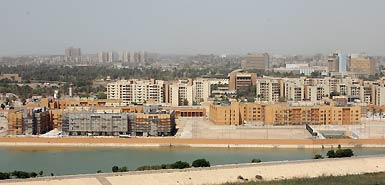|

From The Times
September 1, 2007
Welcome to the new US
embassy
It’s bigger than Saddam’s palace and, with a cinema, gym and pool, is the
safest and smartest place to live in Iraq...
Martin Fletcher in Baghdad
Baghdad is a city of ruins - of burnt-out
homes, of shops wrecked by suicide bombs, of the crumbling shells of
Saddam-era palaces and ministries destroyed by smart bombs in the US invasion of 2003.
There is one notable
exception. It is probably the only big new building proje ct in the capital in
the past four years. It is the new US Embassy on the west bank of the Tigris which the contractors will
transfer to the US Government officially today. ct in the capital in
the past four years. It is the new US Embassy on the west bank of the Tigris which the contractors will
transfer to the US Government officially today.
A towering wall renders
the huge new embassy almost invisible from ground level. For security reasons
the State Department has refused all requests for media tours – promising
instead to release pictures of the interior at some later date. The only way
to view it is from the roof of the Babylon hotel, across the river.
What you can see through
the haze of heat and pollution is a complex of two dozen smart new dun and
grey blocks set in 104 acres (42 hectares) of grounds ringed by that
impregnable wall. It is a fortress within the fortress that is the green
zone. It is designed to repel any physical attack and. when it opens for
business in a few weeks, it will be protected by a detachment of Marines with
their own barracks. It is not, however, invulnerable to criticism.
This
is the largest US Embassy built – roughly the size of Vatican City – and at $600 million (£300
million) the most expensive. At a time when millions of Baghdadis outside the
green zone receive only a couple of hours of water and electricity daily,
Iraqis observe that this project has been completed on time, on budget, and
is entirely self-sufficient with its own fresh water supply, electricity
plant, sewage treatment facility, maintenance shops and warehouses.
“People are very angry,”
said one young Iraqi. “It’s for the Americans, not for the Iraqis.”
There are two office
blocks that will house 1,000 staff, six apartment blocks containing 619
one-bedroom units, spacious residences for the Ambassador and his deputy, a
school, shopping centre and food court; a swimming pool, tennis and
basketball courts; a gymnasium, cinema, beauty salon and social club. This is
known because the architects – Berger Devine Yaeger,
of Kansas City – posted drawings on its website briefly until the
State Department ordered their removal.
The embassy was built
with imported labour. This year a congressional committee heard charges that
First Kuwaiti General Trading & Contracting told a planeload of Filipino
construction workers that they were flying to Dubai to build hotels and did
not admit that they were heading for Baghdad until they had taken off,
forcing them, in effect, to work there.
Critics also portray the
new compound as a symbol of American isolation and occupation, and a sign of
how little confidence the US has in Iraq’s future. Jane Loeffler, an expert on the architecture of embassies,
writes in the latest edition of Foreign Policy magazine: “Encircled by
blast walls and cut off from the rest of Baghdad, it stands out like the crusader
castles that once dominated the Middle East.”
Embassies were
traditionally designed to promote interaction with their host communities,
she says, but not this one. “Although US diplomats will technically be ‘in Iraq’ they may as well be in
Washington.
“Although the US
Government regularly proclaims confidence in Iraq’s democratic future, the US has designed an embassy that
conveys no confidence in Iraqis and little hope for their future. Instead,
the US has built a fortress capable of
sustaining a massive, long-term presence in the face of continued violence.”
Edward Peck, a former US Ambassador to Iraq, says in the same magazine: “The
embassy is going to have a thousand people hunkered behind sand-bags. I don’t
know how you conduct diplomacy in that way.”
US diplomats roll their
eyes in the face of such verbal assaults. “The size and scale of the embassy
reflects very much our expectation of a strong long-term relationship with Iraq,” one senior official insisted.
“Of course it’s a fortress. What embassy isn’t nowadays? Is it a tragedy? Of
course it is. It’s a sad statement of the reality of today’s world.”
The relentless criticism
clearly grates. “We call it the ‘nec’,” he said.
“It stands for the new embassy compound. And it’s a pain in the neck.”
|